
What We’re Growing 2022: Varieties for the Spring & Summer Garden
New year, new homestead, new garden! I’ve always loved seed starting season. Browsing and selecting new varieties to grow, and then lovingly planting teeny tiny seeds that will soon turn into big bountiful harvests. The whole process is magical! This year, we’re especially excited since we have a new large garden space to grow in. In fact, we’re starting more seeds than ever!
Read along to see exactly what we’re growing in our 2022 spring and summer garden. In this post, I will go over all the varieties we plan to grow (organized by category, like squash or tomatoes) along with descriptions, helpful tips and resources along the way.
I’ll be the first to admit: this list is long! Please don’t let that intimidate or overwhelm you. My goal is simply to introduce you to some of our favorite varieties of veggies, flowers and herbs. If you’re new to gardening, start small and grow what feels manageable for you.

Cool vs Warm Season Crops
Since we have a brand new garden space and ever-so-slightly different climate at the new homestead, we’re doing a bit of experimenting this year!
In addition to classic summer crops, you’ll notice a lot of cool-season crops on this list too, like cauliflower, broccoli and cabbage. Before, we used to grow the majority of our cool season veggies during the fall and winter garden – which we’ll continue to do of course! Yet because we have additional space, we’re giving those a go with spring planting this year as well. We’ll transplant those outside a month or two before the heat-loving crops go out.
Not sure when to plant everything? Check your planting calendars – example below. You’ll notice you have the option to grow many cool season crops in either spring OR the fall in most zones. Like us, you may need to experiment to see which season works best for you and your plants! Folks with especially short growing seasons (or where it changes from cold to hot very quickly) may want to consider these fast-growing cool season crops.
Here on the Central Coast of California, our summer weather is very mild – often foggy and cool, and rarely over 80°F. Therefore, I think many cool season crops will last through spring and into summer here. However, we’re prone to occasional heat waves too, so I specifically chose varieties that were described as heat-tolerant and slow to bolt – just in case.
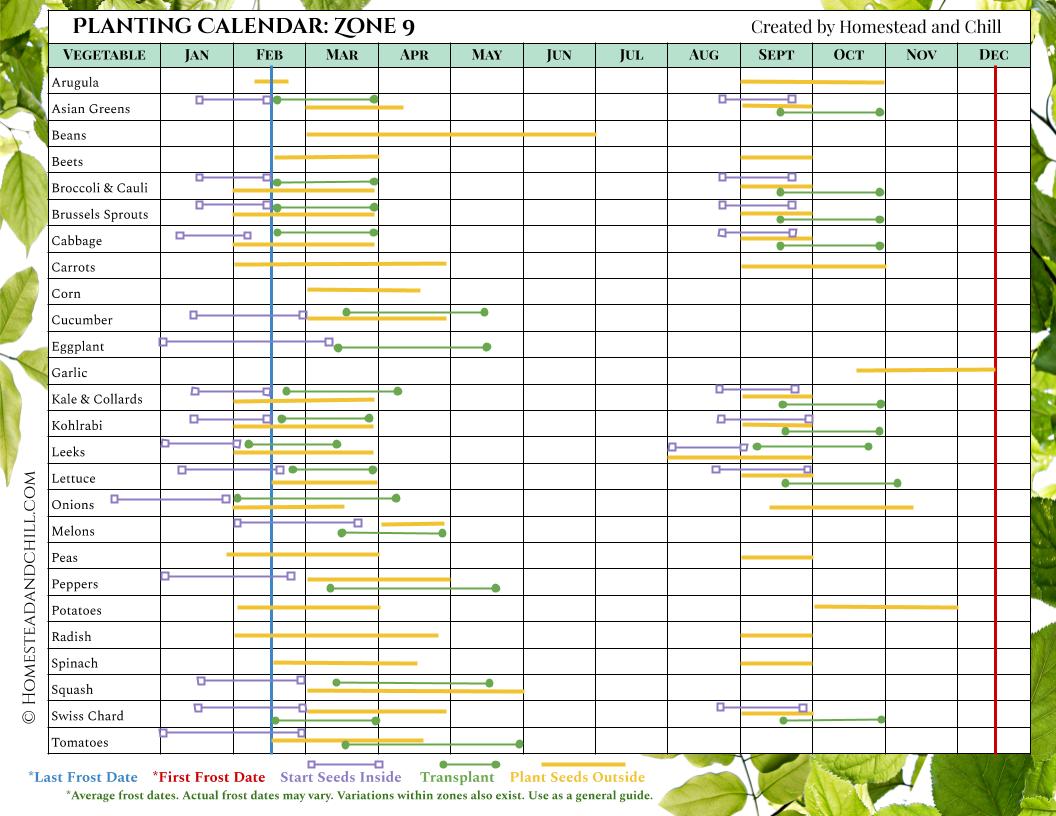
Choosing What to Grow
Decisions, decisions… There are so many fantastic varieties of fruit and vegetables out there to try! While that can be wonderfully exciting, it can also get a bit overwhelming to narrow down your selections – especially if you have a limited space to grow. To help you choose, be sure to carefully read the plant descriptions provided by the seed supplier.
Select varieties that sound tasty and interesting, but also ones that are well-suited for your climate. Certain varieties may offer exceptional heat or cold-tolerance, grow well in high humidity, are quicker (or slower) to mature, or resistant to diseases or pests common to your area. For example, we like to keep an eye out for varieties that are naturally resistant to powdery mildew – a big issue here! Also keep in mind that the varieties we grow may not perform the same in your garden.
In fun related news, I recently signed up as an affiliate with our favorite organic seed company – High Mowing Seeds! That is where we bought 90% of our seeds this season. Using this link to buy seeds will give us a small commission that helps support our family. (We’re so grateful!) See a full list of places to buy organic, heirloom and non-GMO seeds here.


WHAT WE’RE SOWING
Now without further ado (and in no particular order), here is the list of everything we’re growing this year. Many of the goodies on this list are new-to-us varieties, though there are quite a few tried-and-true favorites as well. If you’re new to growing from seed, our Seed Starting 101 guide will help get you going. But there is no shame in buying started seedlings too! Learn how to pick the best seedlings at the nursery here.
Tomatoes
When it comes to tomatoes, we seek out early-maturing varieties or those said to ripen well in cooler weather. Smaller varieties usually perform best for us. As much as I’d love to grow them, big beefy heirlooms usually love more heat than our climate offers! We also grow a combination of determinate and indeterminate varieties. Learn more in our full Organic Tomato Grow Guide, which covers tips for pruning and training tomatoes too.
- Valentine. A highly productive red grape tomato with firm flesh, delicious flavor and holds up well after harvest. Indeterminate.
- Pink Boar. Beautiful, petitie (2-4 oz) wine-colored fruits with metallic green stripes. Said to perform well in challenging climates. Indeterminate.
- Moskvich. Big red 4-6 oz fruits that are ideal for fresh eating or preserving. Like all Russian varieties, it can tolerate cooler growing conditions. Semi-determinate.
- Mountain Merit. Excellent red slicing tomato with firm flesh and 8-10 oz fruit. Productive and highly disease resistant. Determinate.
- Indigo Apple. Stunning 4-6 oz fruit that turn dark purple as they ripen, contains high levels of the antioxidant anthocyanin. Resistant to cracking and sunscald. Indeterminate.
- Granadero. Large plum tomatoes 4-5 oz in size. Produces abundant and continued yields throughout the season. Offers high disease resistance. Great variety for homemade tomato sauce. Indeterminate.
- Other favorites from seasons past (which we may still grow this year, TBD) include Sungold cherry, Stupice, Green Zebra, and Amber.

Squash & Pumpkins
Zucchini and summer squash are always a staple, but we’re stoked to grow hard winter squash and pumpkins this year too! Between space constraints and lackluster results, we usually skipped out on growing sprawling winter squash varieties in the past. Our new climate is a few degrees warmer in the summer, so I hope the hard squash we’ve selected will be happier here!
- Dunja Zucchini. Our go-to green zucchini variety. The plants are beautiful, prolific, and naturally resistant to powdery mildew!
- Butta Squash. A very prolific straight summer squash, aptly named for its smooth creamy texture and light yellow color. Another repeat favorite.
- Bennings Green Tint Summer Squash. A cute green scalloped patty pan that grows on compact bushy plants. It should be fun for summer grilling!
- Pie-Pita Hulless Pumpkin. This pie pumpkin variety produces already-shelled (hulless) pumpkin seeds inside – making it ideal to use for its flesh AND highly edible seeds.
- Sugar Dumpling. A beautiful and petite sugar dumpling winter squash, which grows on fairly compact bushy plants that are resistant to powdery mildew.
- Nutterbutter Butternut or Butterscotch Butternut. We got seeds for both, but I haven’t decided which one we’ll grow this year yet! Nutterbutter sounded especially appealing for us: “reliably matures in regions that have trouble ripening butternuts”. Butterscotch grows on especially compact plants that are PM-resistant.
- Baby Blue Hubbard Squash. A smaller version of the unique teardrop-shaped blue hubbard squash, with smooth blue-gray skin and sweet yellow-orange flesh.
Psst! Have you ever had zucchini or other squash that starts to grow, but then shrivels or rots on the vine? Chances are it wasn’t properly pollinated! Learn how to easily hand pollinate squash to prevent end rot here, or visit our full Zucchini & Summer Squash grow guide.


Beans
Beans have slowly become one of my favorite summer crops over the years. I mean, who doesn’t love a fresh homegrown green bean? Plus, they do better in our mild summers than some other warm season veggies do. Quick tip: soak bean seeds in water for several hours before direct-sowing them outside for a speedy germination! Pop over to our bean grow guide for even more tips, and be sure to come back and try our fermented dilly bean recipe later.
- Bush Beans: Most of the beans we grow are bush bean varieties, perfect for succession sowing all season long. In addition to classic green beans (like Provider or Jade bush beans), we’re particularly fond of beautiful purple and white Dragon Langerie, red-streaked Borlotto, tender Gold Rush Yellow Wax, and flat tender Roma type bush beans.
- Pole Beans: Pole beans (climbing, vining types) usually take longer to grow and bear fruit than bush beans, but they produce more and over a longer season. Plus, nothing says summer more than a trellis dripping with beans! This year we plan to grow Blauhilde Pole and NorthEaster Pole beans.
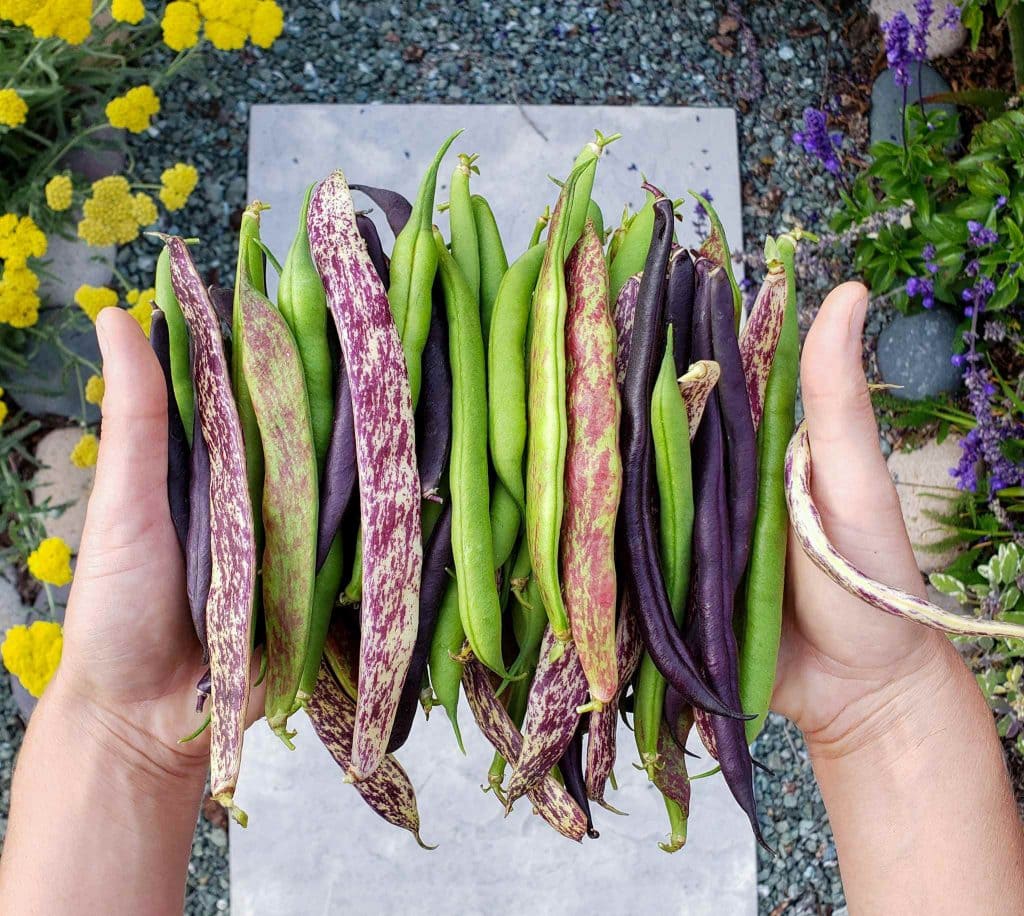
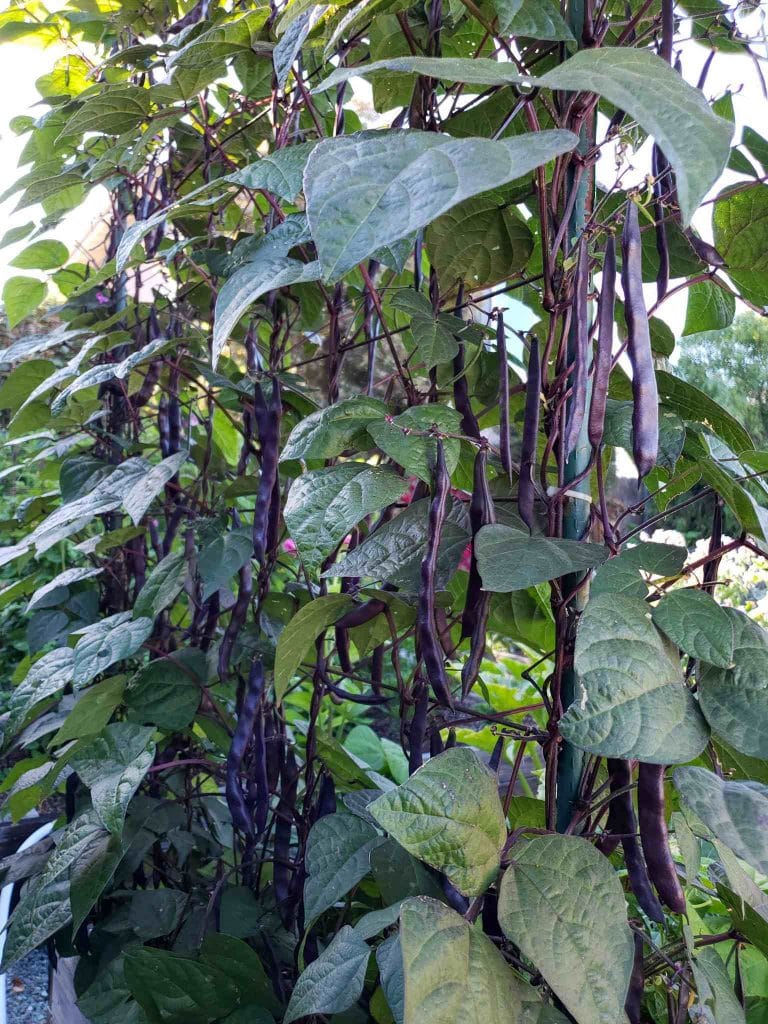
Brassicas: Cabbage, Cauliflower, Broccoli & Kohlrabi
All of these heading brassica varieties are described as heat tolerant, ideal for our spring to summer garden! We’re saving the less heat tolerant varieties for our fall to winter garden, such as Veronica Romanesco.
- Cabbage. Integro cabbage is our favorite mid-size red cabbage variety. Expect cabbage has dense, uniformly round green cabbage with notable heat tolerance
- Cauliflower. We’re growing a rainbow of cauliflower this season, including: Lavender (a beautiful light purple cauliflower variety, new to us), Bermeo (an early-maturing classic white cauliflower with dense uniform heads), Flame Star (an orange-yellow cauliflower, similar to the popular “cheddar” variety but more heat tolerant) and Vitaverde (a rad chartreuse green variety).
- Broccoli. Covina broccoli is a new-to-us variety said to reliably perform in a wide variety of climates, including hot dry weather or wet cold conditions. Belstar broccoli is a trusty broccoli variety that has done well for us in the past. Once the main head is harvested, the plants consistently produce side shoots (mini heads of broccoli).
- Kohlrabi. I love this alien-like veggie. Haven’t tried it? Kohlrabi tastes like a super sweet, crisp, juicy inner portion of a fat broccoli stem. This year we’ve sowed seeds for Kordial, Kolibri, and Kossak kohlrabi.
Related: How to Grow Cauliflower (and Romanesco) from Seed to Harvest


Peppers
I always say we aren’t going to grow “as many” peppers each year, but somehow end up with a decently long list anyways! This year, we’re mostly focusing on sweet and mild varieties that we can enjoy fresh – though we’ll grow several hot chilis too. I’m personally not a huge fan of spicy foods, but I sure do love our fermented hot sauce and homegrown chili powder! Being homemade, we’re free to customize them with a blend of both hot and sweet peppers to suit our taste buds.
- Red Picnic. A bright red bell pepper with 3-5 inch fruit, boasting super sweet and complex flavor.
- Lilo Sweet. Unique 3 inch dark purple bell pepper that will turn a deep red color if left to mature longer. The purple fruit tastes reminiscent of green bell pepper.
- Bastan. A poblano pepper with mild heat has thick walls ranging in color from dark green to chocolate. A perfect pepper to stuff when grilling, baking, or frying.
- Habanada. Bright orange 2-3 inch thin-walled sweet peppers with all the fruity, floral, and complex flavors of a habanero – minus the heat!
- Black Magic. A jalapeno pepper variety with bountiful yields. Less heat than some other jalapeno varieties.
- Glow. A sweet, orange, large bell pepper type, known to be easy to grow in diverse climates. One of our favorites!
- Iko Iko. An early-season colorful bell pepper. Produces 3 inch fruit in a range of colors: yellow, purple, or light green when young, all maturing into bright orange and red fruit streaked with purple.
- Aji Rico. A medium-hot pepper with sweet citrus-like notes. It ripens earlier than most, but can be enjoyed at any stage of maturity. Mature fruit is bright red and has thin walls, perfect for drying into beautiful red “paprika” style chili powder.
- King of the North. Sweet red bell pepper. Another good early-season producer, ideal for cooler regions or those with short seasons.
- Red Ember. A mild-medium hot Cayenne pepper type, great for using fresh or creating powder.
- Other favorites include shishito peppers (SO good pan-blistered!) and banana peppers, which make excellent pepperoncini-style pickled peppers.
Related: How to Grow Peppers and Chilis: Seed to Harvest


Greens
If you know me, you know I LOVE my leafy greens! (I must be part rabbit.) We grow an even wider array of greens during the fall and winter, but always make room for a handful of our favorite heat-tolerant greens in spring. Some may grow right through summer, like collard greens, swiss chard, and select kale varieties. The lettuce may not last as long, but we can always plant some bush beans, summer squash, radishes, or other fast-maturing summer veggies in their place once the lettuce kicks the bucket.
- Kale. Dazzling Blue lacinato and Madeley kale are two of our go-to slow-bolting varieties.
- Mustard greens. We plant Komatsuna mustards every year, and are trying out Golden Frill and Wasabina Mustards as new additions this spring.
- Swiss Chard. I have yet to find a chard I love more than Peppermint swiss chard (named for its candy-striped stalks, not flavor!) but are also growing this gorgeous yellow-stemmed Sunset Chard this season too.
- Champion Collards. We’ve tried various collard green varieties over the years, but always seem to come back to this one.
- Joi Choi Bok Choy. My favorite green of all time! The big thick juicy stalks and open heads are perfect for cut-and-come-again or perpetual harvesting. It doesn’t love hot weather, but is far more slow-bolting than most varieties of bok choy.
- Lettuce. This spring/summer, we’re experimenting with six new varieties, all described as heat-tolerant: Nevada, Freckles, Magenta, Red Mist, Black Seeded Simpson and Muir.

Annual Flowers
In addition to the myriad of perennial flowers we have planted around the property, we’ll grow plenty of annual flowers too. Some will be planted in flower beds or containers around the garden, but many flowers will be tucked right into the raised beds amongst the veggies. They’ll add a beautiful pop of color, draw in pollinators, and some even deter pests. Learn more about companion planting here, and a full list of our top 23 plants for pollinators here.
- Calendula: We sowed seeds for Strawberry Blonde, Orange King, Resina, Orange Button, Pink Surprise, and Pacific Beauty this season. Calendula is my FAVORITE flower (actually a medicinal herb) in the garden! See: “All About Calendula: How to Grow, Harvest, Dry & Use Calendula Flowers” to learn more.
- Marigolds: Did you know these repel root knot nematodes? I’m not 100% sure which varieties we’ll grow yet, but we are particularly fond of Tangerine Gem, Hawaii Giant, and classic french marigolds.
- Sunflowers: We have SO many sunflower seeds! Lemon queen, Garnet Star, Evening Colors, Sonja, Goldy Double, Mammoth, Strawberry Blonde, Autumn Beauty, and Mexican Sunflowers (though not a true sunflower). We enjoy a lot of branching, multi-headed types.
- Zinnia varieties: Zinnia are a close runner-up to calendula, and a monarch butterfly favorite! Our zinnia seed collection includes Giant Coral, Purple Prince, Giant Yellow, Benary’s Giant Salmon Rose, Queen Red Lime, Oklahoma Carmine and Gold, and many more.
- Borage. Borage is a bee-magnet, and a nutrient-dense addition to compost or mulch. However, keep in mind that it readily self-seeds – popping back up year after year.
- Nasturtium. I miss our established volunteer patches of nasturtium at the old homestead! In addition to attracting pollinators, both the leaves and flowers are edible. They taste peppery like arugula. I like growing compact nasturtium varieties (like Alaska Mix) as companion plants in the raised beds, while letting the sprawling varieties grow in border areas (or, allow them to trail down the outside of a raised bed).
- Cosmos. I’ve never met a cosmos I didn’t like, but this season we’ll probably pop seeds for fancy Seashell cosmos and this Sensation blend.
For cultivation tips on all these beauties, see: 7 Best Easy Annual Flowers to Grow from Seed

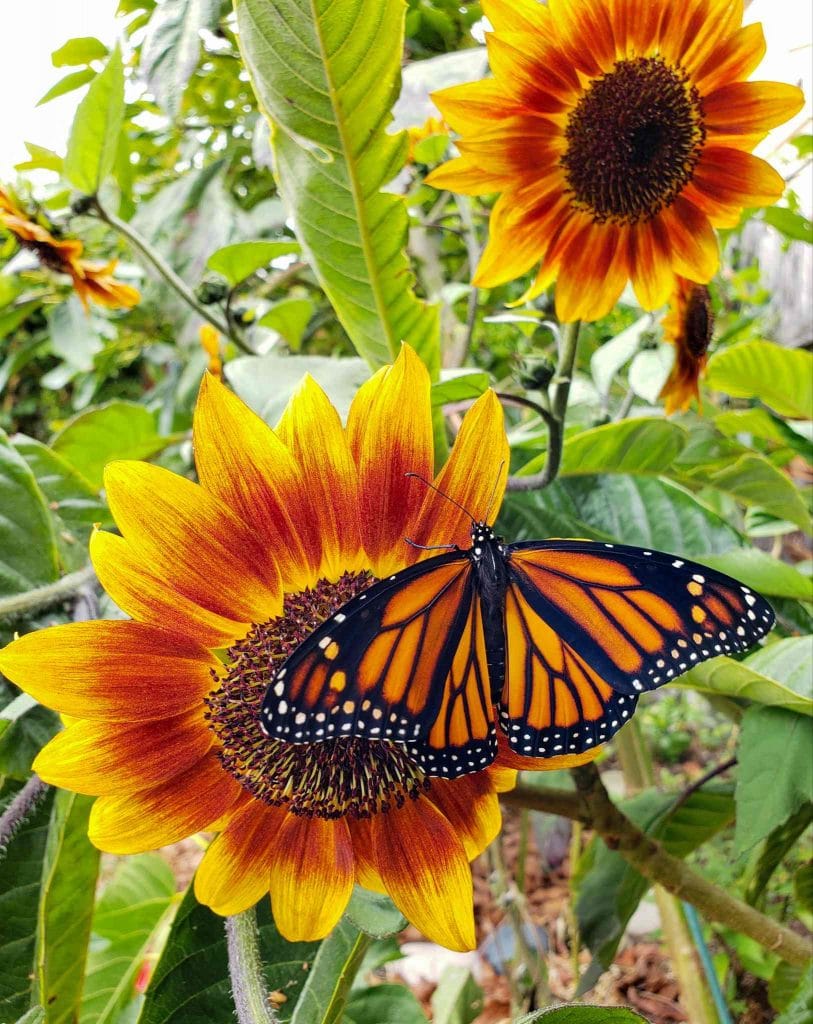

Herbs
Thanks to our temperate climate, we already have many established patches of herbs that grow as perennials here – sage, rosemary, oregano, bay laurel, lemon balm, mint, and thyme. This season, we plan to start a handful of annual herbs as well, including:
- Santo cilantro
- Dill Delight and Bouquet dill – ideal for adding to homemade pickles
- Basil: Prospera Italian Large Leaf Basil, Lemon Basil, Sweet Thai Basil, and Rutgers Devotion Basil – a Genovese type.
We always grow gobs of basil so we can stock up the freezer with enough Besto Pesto for the whole year, along with dried basil leaves for the pantry. Learn how to grow bushy basil to harvest all season long here. (Hint: pruning young seedlings and routinely cutting back established plants are key!) Also feel free to check out our Herbs 101 guide.
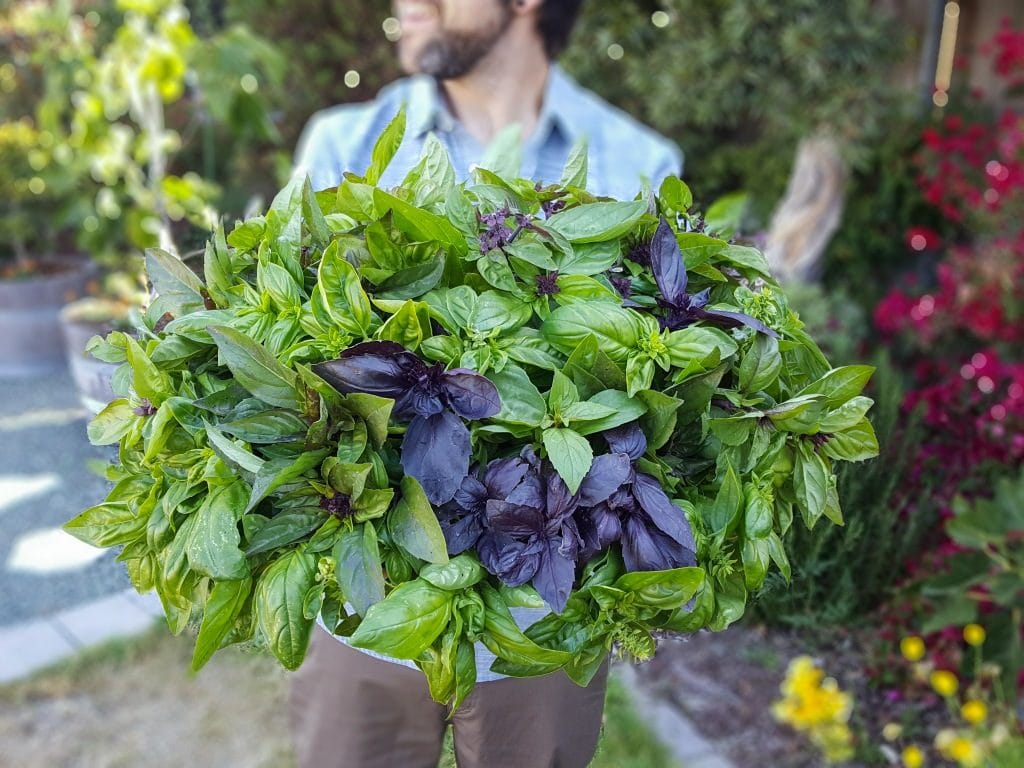

Root Veggies
Rather than starting indoors, it’s best to direct sow root vegetable seeds. That is, to plant their seeds directly in soil where they will stay and grow for the season. Root veggies don’t take kindly to transplanting. On the other hand, they’re one of THE most satisfying things to harvest. The suspense and big reveal when they’re unearthed can’t be beat!
- Radishes are one of our favorite root veggies. They come in many unique colors, shapes, sizes and flavors. Some of our favorites include egg-shaped purple Bravo daikons, attractive and reliable Pink Beauty, and juicy, mild White Daikon radishes. To learn all about growing radishes from seed to table, see this article.
- Carrots. We always grow several different varieties and colors of carrots including Dolciva, Cosmic Purple, Naval, White Satin, Scarlet Nantes, and more. Get tips on how to successfully grow carrots in our carrot grow guide.
- Beets have been hit and miss for us in the past. This year, we are growing just a couple varieties: Chioggia, Formanova, and Boro Beets.
- Turnips aren’t as popular as other root veggies, but I say give them a try! We’re growing some large Purple Top White Globe turnips as well as smaller, tender Tokyo Market salad turnips that are ideal to enjoy fresh and raw.
- Potatoes. We ordered nearly a dozen different potato varieties (all from High Mowing) that will arrive in April. We love growing potatoes in large durable fabric grow bags, which means we can always find some space for them! Interested in growing your own spuds? Learn how we grow potatoes in containers here.


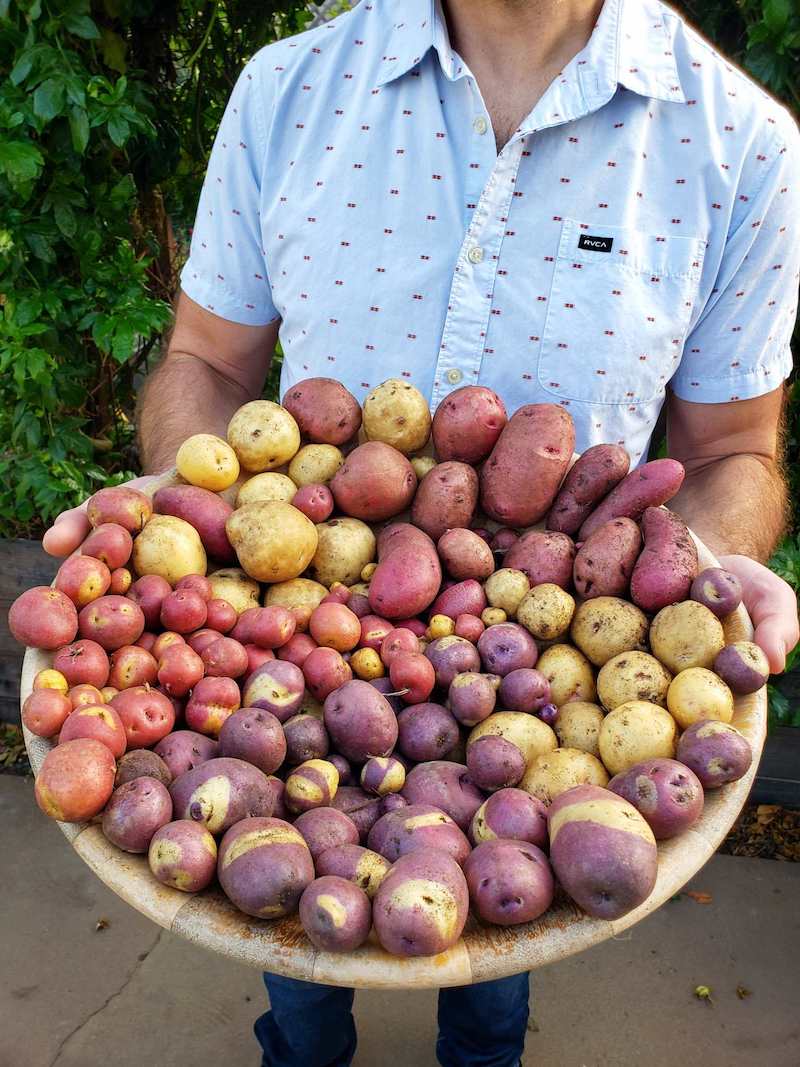
Eggplant
Eggplant has been a mediocre performer for us in the past – but we’re giving it another shot nonetheless! It thrives in warm conditions, so we’re hoping our new location will make them grow better than before. We chose small, early-maturing eggplant varieties to help ensure success.
- Little Finger. An early and productive plant that produces 3 to 6 inch slender dark purple fruit with wonderfully thin skin.
- Diamond. A great short season variety that produces clusters of 6-8 inch oblong fruit.
- Ping Tung Long. An Asian variety of eggplant that produces long and slender fruit 12-14 inches long with thin skin and bright lilac color. My favorite!
- Piccolo. Small 3-4 inch ovate (egg-shaped) fruit with stunning purple and white variegated striping. Productive variety that will bear fruit over a long season.

Cucumber
Like eggplant, cucumbers didn’t favor our previous climate. We were only a mile from the ocean and socked in with fog most of April through August. Now that we’re a few miles inland and a few degrees warmer during summer, I hope this year’s cucumbers will be a wee less sad!
- Manny. A vining plant that produces thin-skinned 5-7 inch crisp fruit. Early maturing, high yielding, and good disease resistance.
- Tasty Green. An Asian burpless variety that produces super long 9” fruit with thin skin and sweet flesh. Produces heavy yields. Best results when trellised.
- H-19 Little Leaf. Compact, vining plant that produces high yields of petite 3-4 inch fruit. Good for eating fresh; ideal for pickling. Great disease resistance as well.
- Cucamelon. While we didn’t grow the best classic cukes in the past, our cucamelon vines grew and fruited prolifically! Even better, we were able to dig up their tubers and bring them along to the new homestead. Learn all about growing cucamelons here.

Miscellaneous Tasties
- Leeks. This season we’re growing Runner and King Richard leeks. Surfer was another great variety we’ve enjoyed in the past. Leeks are SO delicious and easy to grow. Learn how here.
- Onions. We’ve already started sweet Walla Walla, Rossa Di Milano red onions, and Calibra spanish onions. When growing onions, it’s crucial to choose the right variety for your latitude – short day, long day, or intermediate day onions. I prefer to start from seed or seedlings rather than sets. Visit our onion grow guide for more info and tips for success.
- Celery. We are growing celery for the first time ever! We chose to start with Tango Celery, described as an early and easy-to-grow variety, perfect for short seasons and home gardeners. Stalks are crunchy with minimal stringiness.
- Artichokes. This is another first for us – from seed, that is! We’ve grown artichokes from nursery seedlings in the past but are excited to grow big Wonder chokes from seed this year. If you aren’t familiar with preparing artichokes, learn one really easy way to cook and eat them here.
- Sugar Snap Peas. Duh. A spring staple! If you need an easy and inexpensive trellis for growing peas, beans, or any other vining plant, pop over to our DIY trellis tutorial.
- Melons! These get an exclamation mark because my gardening journey began with melon. About 14 years ago I planted a cherry tomato, a couple squash, and a honeydew melon in my first garden. It was the best damn melon I’ve ever tasted, and I blame it for getting me hooked on gardening! But that was back in Chico CA where the summers are hot as heck. Fast forward to our last coastal homestead… homegrown melons were never the same. They did so lousy that we simply gave up growing them. This year, we’re trying Sivan and Delicious 51 melons – both petite varieties that are said to ripen well in cool weather, and resistant to powdery mildew.

Who’s ready to grow along?
Well, that about sums up our spring and summer garden plan for 2022! I told you it was a lot. 😬 We’re so eager to get growing in our new garden and see how everything does. Not to mention navigating through the unknowns that come along with brand new soil, possibly new pests, and other unpredictable factors. Thank you so much for following along! I hope you discovered some new varieties or veggies to try. Feel free to drop some of your favorite veggies or varieties in the comments below!
Other Useful Resources to Explore:
- Seed Starting 101: How to Sow Seeds Indoors
- How to Design & Build a Raised Garden Bed
- How to Fill a Raised Garden Bed: Build the Perfect Organic Soil
- Transplanting Seedlings Outside: Best Practices for Success
- How to Fertilize & Amend a Raised Garden Bed Before Planting (or Between Seasons)









20 Comments
Heather
I’ve never been a huge fan of collards, with how tough they are. But I’ve got some planned for my garden anyway! How do you like to use them?
Aaron (Mr. DeannaCat)
Hi Heather, we typically just saute collard greens with other leafy greens in butter or oil, we also like to use them in soup but we always remove the stems beforehand no matter how we are going to cook them. Cooking them for a longer amount of time will make them less tough as well. Hope that helps and have fun in your garden!
Margrit
Kohlrabi was always grown in my German mom’s garden.
Mom’s Kohlrabi recipe
Peel and cut Kohlrabi into thicker matchstick pieces.
Steam until tender and serve with parsley sauce.
Mom’s Parsley Sauce
Roux (melt butter and add enough flour to soak up the butter. Cook a bit until flour is no longer raw BUT still white) add milk to the roux and cook on low until the milk thickens.
Add salt & pepper to taste
Add enough finely chopped parsley (she used curly, I think flat Italian tastes better) to the sauce
until it’s tinged green.
To serve, pour sauce over steamed kohlrabi.
Aaron (Mr. DeannaCat)
Wow, that sounds delicious Margrit! Thank you for sharing.